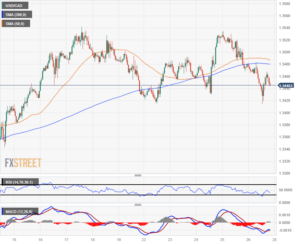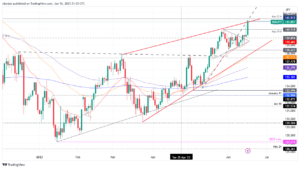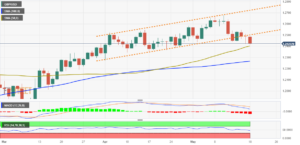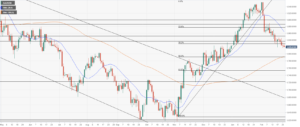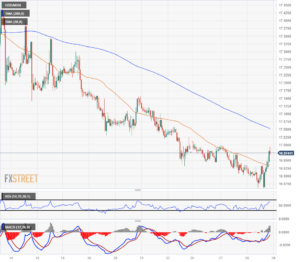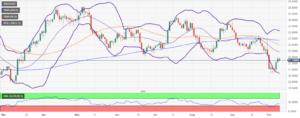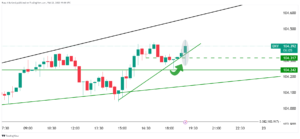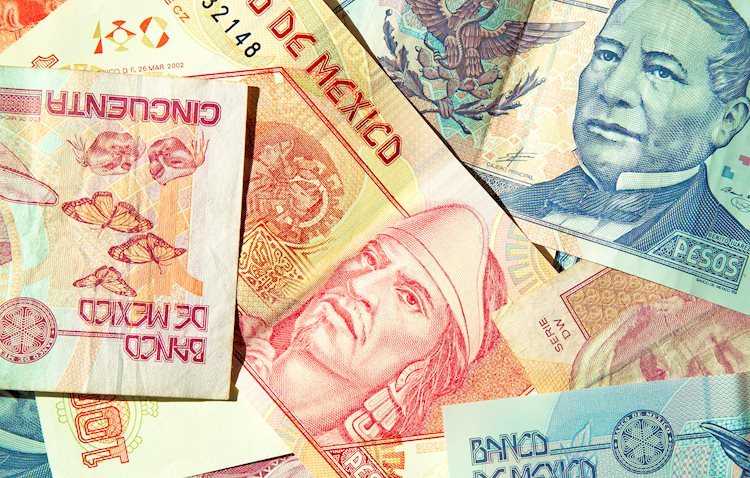
- Mexican Peso weakens as Banxico’s officials discuss easing policy next year.
- Banxico revised up growth prospects for Mexico and expected inflation to cool to its target in 2025.
- The US disinflation process continues, data shows, while traders trim rate cut expectations by the Fed, bolstering the US Dollar.
Mexican Peso (MXN) drops sharply for the second straight day against the US Dollar (USD) during the North American session on Thursday. The latest data from the United States (US) is sponsoring a leg-up in the Greenback (USD), underpinned by high US Treasury bond yields, a tailwind for the USD/MXN. At the time of writing, the exotic pair exchanges hands below the 17.40 area, printing gains of more than 0.80%.
Mexico’s economic docket witnessed the release of the Unemployment Rate, which came a tenth lower in non-seasonally adjusted figures at 2.7% YoY, below forecasts of 2.8% and beneath September’s 2.9%. The Bank of Mexico (Banxico) revised its economic growth forecasts for 2023 and 2024 to the upside in its quarterly report, released on Thursday. The bank noted that inflation would take longer than expected to dip to the bank’s target, projecting that it would hit the 3% target by 2025.
During Banxico’s presentation of its quarterly economic projections, Governor Victoria Rodriguez Ceja kept the door open for rate cuts, but discussions would be held in the first quarter of 2024. Banxico’s Deputy Governor Jonathan Heath echoed some of Rodriguez’s comments, though he pushed back against easing monetary policy in the first quarter.
Across the border, the United States (US) economic calendar revealed the Federal Reserve’s (Fed) preferred inflation gauge, cooled as expected. Yet after the data, investors trimmed their aggressive Fed rate cut expectations for 2024, while the USD/MXN rose to a daily high of 17.49 before retreating below 17.45.
Daily digest movers: Mexican Peso heavy as the USD/MXN climbs to a new two-week high near 17.50
- Banxico revises economic growth upward from 3% to 3.3% for 2023 and projects the economy would pick up from 2.1% to 3% in 2024.
- Regarding inflation prospects, the Mexican central bank foresees headline inflation at 4.4% in Q4 2023 (5.3% for core), while at the end of 2024, it is estimated at 3.4% (3.3% for core). The central bank forecasts headline and core inflation to not hit the 3% target imposed by the institution until 2025.
- The US Core Personal Consumption Expenditures (PCE), the Fed’s gauge for inflation, rose by 3.5% YoY in October, as expected, below the previous month’s 3.7%.
- Headline inflation measured by the PCE slowed from 3.4% to 3.0% in the last twelve months, as foreseen by analysts.
- US Initial Jobless Claims for the week ending November 25, rose by 218K, less than the 220K estimated, but exceeded two week’s ago figures of 211K.
- Interest rate traders expect 108 basis points of rate cuts by the US Federal Reserve in 2024.
- On November 27, Banxico’s Deputy Governor, Jonathan Heath, commented that core prices must come down more, adding that one or two rate cuts may come next year, but “very gradually” and “with great caution.”
- On November 24, a report revealed the economy in Mexico grew as expected in the third quarter on an annual and quarterly basis, suggesting the Bank of Mexico would likely stick to its hawkish stance, even though it opened the door for some easing.
- Mexico’s annual inflation increased from 4.31% to 4.32%, while core continued to ease from 5.33% to 5.31%, according to data on November 23.
- The financial markets’ narrative that the US Federal Reserve (Fed) is done hiking rates has kept the Greenback on the backfoot, but today, it has found some relief.
- A Citibanamex poll suggests that 25 of 32 economists expect Banxico’s first rate cut in the first half of 2024.
- The poll shows “a great dispersion” for interest rates next year, between 8.0% and 10.25%, revealed Citibanamex.
- The same survey revealed that economists foresee headline annual inflation at 4.00% and core at 4.06%, both readings for the next year, while the USD/MXN exchange rate is seen at 19.00, up from 18.95, toward the end of 2024
Technical Analysis: Mexican Peso could weaken further as USD/MXN buyers target the 200-day SMA
Although the USD/MXN remains bearish, the jump above the confluence of the 20 and 100-day Simple Moving Averages (SMAs), each at 17.34/35, respectively, opened the door to challenge the 17.50 psychological level for the first time since November 14. A decisive break of that level could pave the way for testing the 200-day SMA at 17.57, ahead of challenging the 50-day SMA at 17.69
On the other hand, a retracement back below the confluence of the 20 and 100-day SMAs could sponsor a drop toward the November 29 daily close of 17.25, a strong resistance level, which turned support. Once cleared, the next support would be 17.05.ble investment alternative.
Interest rates FAQs
Interest rates are charged by financial institutions on loans to borrowers and are paid as interest to savers and depositors. They are influenced by base lending rates, which are set by central banks in response to changes in the economy. Central banks normally have a mandate to ensure price stability, which in most cases means targeting a core inflation rate of around 2%.
If inflation falls below target the central bank may cut base lending rates, with a view to stimulating lending and boosting the economy. If inflation rises substantially above 2% it normally results in the central bank raising base lending rates in an attempt to lower inflation.
Higher interest rates generally help strengthen a country’s currency as they make it a more attractive place for global investors to park their money.
Higher interest rates overall weigh on the price of Gold because they increase the opportunity cost of holding Gold instead of investing in an interest-bearing asset or placing cash in the bank.
If interest rates are high that usually pushes up the price of the US Dollar (USD), and since Gold is priced in Dollars, this has the effect of lowering the price of Gold.
The Fed funds rate is the overnight rate at which US banks lend to each other. It is the oft-quoted headline rate set by the Federal Reserve at its FOMC meetings. It is set as a range, for example 4.75%-5.00%, though the upper limit (in that case 5.00%) is the quoted figure.
Market expectations for future Fed funds rate are tracked by the CME FedWatch tool, which shapes how many financial markets behave in anticipation of future Federal Reserve monetary policy decisions.
- SEO Powered Content & PR Distribution. Get Amplified Today.
- PlatoData.Network Vertical Generative Ai. Empower Yourself. Access Here.
- PlatoAiStream. Web3 Intelligence. Knowledge Amplified. Access Here.
- PlatoESG. Carbon, CleanTech, Energy, Environment, Solar, Waste Management. Access Here.
- PlatoHealth. Biotech and Clinical Trials Intelligence. Access Here.
- Source: https://www.fxstreet.com/news/mexican-peso-treads-water-as-the-us-dollar-counterattacks-202311301543
- :has
- :is
- :not
- $UP
- 10
- 14
- 17
- 19
- 2%
- 20
- 2023
- 2024
- 2025
- 220K
- 23
- 24
- 25
- 27
- 28
- 29
- 32
- 33
- 40
- 49
- 50
- 8
- a
- above
- According
- adding
- Adjusted
- After
- against
- aggressive
- ago
- ahead
- alternative
- American
- an
- analysis
- Analysts
- and
- Animate
- annual
- anticipation
- ARE
- AREA
- around
- AS
- asset
- At
- attempt
- attractive
- back
- Bank
- Banks
- base
- basis
- BE
- bearish
- because
- before
- below
- between
- bolstering
- bond
- Bond yields
- boosting
- border
- borrowers
- both
- Break
- but
- buyers
- by
- came
- case
- cases
- Cash
- caution
- central
- Central Bank
- Central Banks
- challenge
- challenging
- Changes
- charged
- claims
- Close
- CME
- come
- commented
- comments
- confluence
- consumption
- content
- continued
- continues
- Cool
- Core
- core inflation
- Cost
- could
- country’s
- Currency
- Cut
- cuts
- daily
- data
- day
- decisions
- decisive
- depositors
- deputy
- Digest
- Dip
- discuss
- discussions
- Dollar
- dollars
- done
- Door
- Dovish
- down
- Drop
- Drops
- during
- each
- ease
- easing
- echoed
- Economic
- Economic growth
- economists
- economy
- effect
- end
- ending
- ends
- ensure
- estimated
- Even
- example
- exceeded
- exchange
- Exchange rate
- Exchanges
- Exotic
- expanded
- expect
- expectations
- expected
- Falls
- FAQ
- Fed
- fed funds rate
- Federal
- federal reserve
- Federal Reserve’s
- Figure
- Figures
- financial
- Financial institutions
- First
- first time
- FOMC
- For
- forecasts
- foresee
- found
- from
- funds
- further
- future
- Gains
- gauge
- generally
- Global
- Gold
- Governor
- great
- Greenback
- grew
- Growth
- Half
- hand
- Hands
- Have
- Hawkish
- he
- headline
- heavy
- Held
- help
- High
- hiking
- Hit
- holding
- How
- HTTPS
- if
- imposed
- in
- Increase
- increased
- inflation
- inflation rate
- influenced
- initial
- instead
- Institution
- institutions
- interest
- Interest Rates
- investing
- investment
- Investors
- IT
- ITS
- jobless claims
- jonathan
- jpg
- jump
- kept
- Last
- latest
- LEND
- lending
- less
- Level
- likely
- LIMIT
- Loans
- longer
- lower
- lowering
- make
- mandate
- many
- Markets
- May..
- means
- measured
- meetings
- Mexico
- mixed
- module
- Monetary
- Monetary Policy
- money
- months
- more
- most
- Movers
- moving
- moving averages
- must
- NARRATIVE
- Near
- New
- next
- normally
- North
- noted
- November
- october
- of
- officials
- on
- once
- ONE
- open
- opened
- Opportunity
- or
- Other
- overall
- overnight
- paid
- pair
- Park
- pave
- pce
- personal
- Peso
- pick
- Place
- placing
- plato
- Plato Data Intelligence
- PlatoData
- points
- policy
- poll
- preferred
- presentation
- previous
- price
- Prices
- printing
- process
- projections
- projects
- prospects
- psychological
- pushed
- pushes
- Quarter
- raising
- range
- Rate
- Rates
- release
- released
- relief
- remains
- report
- Reserve
- reserves
- Resistance
- respectively
- response
- Results
- retracement
- Revealed
- Rises
- ROSE
- s
- same
- Savers
- Second
- seen
- session
- set
- shapes
- Shows
- Simple
- since
- SMA
- SMAs
- some
- sponsor
- sponsoring
- Stability
- stance
- starts
- States
- Stick
- straight
- Strengthen
- strong
- substantially
- Suggests
- support
- Survey
- Tailwind
- Take
- Target
- targeting
- Testing
- than
- that
- The
- the Fed
- The US Federal Reserve
- their
- they
- Third
- this
- though?
- thursday
- time
- to
- today
- tool
- toward
- Traders
- treasury
- Turned
- two
- underpinned
- unemployment
- unemployment rate
- United
- United States
- until
- Upside
- upward
- us
- US banks
- US Dollar
- US Federal
- us federal reserve
- US Treasury
- USD
- usually
- Victoria
- View
- Way..
- week
- weigh
- which
- while
- with
- witnessed
- would
- writing
- year
- yet
- yields
- zephyrnet

